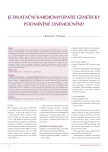The BARI 2D study – secondary prevention and the best treatment strategies in type 2 diabetes patients with ischaemic heart disease
Authors:
L. Pavlíčková; P. Neužil; P. Niederle
Authors‘ workplace:
Kardiologické oddělení Nemocnice Na Homolce, Praha
Published in:
Kardiol Rev Int Med 2007, 9(4): 236-240
Category:
Editorial
Overview
BARI 2D is a multi–centre prospective international study. Its purpose is to define the best treatment for type 2 diabetes patients with stable ischaemic heart disease (IHD). The primary objective is to compare the overall mortality rates for the group of patients with early revascularisation – coronary angioplasty (PCI) or aortocoronary bypass (CABG) with aggressive medication – and for the group only receiving aggressive medication. At the same time, 2 types of treatment of diabetes are compared. The objective of the paper is to present the design of the study and the baseline characteristics of the patients enrolled in the study in the Czech Republic (their cardiac and metabolic status, lifestyle and treatment, as well as the type of revascularisation chosen according to the extent of coronary artery disease), and to compare these with the characteristics of the patients enrolled in the study in the USA. The baseline data show that there are no significant demographic differences between American and Czech participants in the study. Upon enrolment, Czech patients have the same body mass index (BMI), comparable hypertension and hypercholesterolaemia compensation, but worse diabetes (DM) compensation, worse design of secondary preventive treatment, a higher smoker rate and lower regular physical activity rate. They have also undergone less previous revascularisations, with the CABG option being preferred
to PCI in diseases of 2–3 arteries. Definitive results of the study will be published after its conclusion.
Keywords:
ischaemic heart disease – diabetes mellitus – BARI 2D study – revascularisation – lifestyle – secondary prevention
Sources
1.Detre K, Frye R, Genuth S et al. Treatment of Coronary Artery Disease and Type 2 Diabetes Mellitus: The Rationale for the Bypass Angioplasty Revascularization Investigation 2 Diabetes (BARI 2D) Trial. Am J Cardiol 2006; 97(suppl G): 1G-58G.
2.Annaswamy R, Seely E, Bekins S et al. Rosiglitazon improves insulin sensitivity and lowers blood pressure in hypertensive patients. Diabetes Care 2003; 26: 172-178.
3.BARI Investigators. Influence of diabetes on 5-year mortality and morbidity in a randomized trial comparing CABG and PTCA in patients with multivessel disease: the Bypass Angioplasty Revascularization Investigation (BARI). Circulation 1997; 96: 1761-1769.
4.Bonora E, Targher G, Formentini F et al. The metabolic syndrome is an independent predictor of cardiovascular disease in type 2 diabetic subjects. Prospective data from the Verona diabetes complication study. Diabet Med 2002; 21: 52.
5.Cífková R, Býma S, Češka R et al. Prevence kardiovaskulárních onemocnění v dospělém věku. Společné doporučení českých odborných společností. Cor Vasa 2005; 47(Suppl 9): 3-14.
6.Cífková R, Škodová Z. Dlouhodobé trendy hlavních rizikových kardiovaskulárních onemocnění v české populaci. Čas Lék Čes 2004; 143: 219-226.
7.Čech J, Rosolová H, Mayer O jr et al. Rozdíly v intervenci rizikových faktorů ischemické choroby srdeční v rámci sekundární prevence mezi diabetiky a nemocnými bez diabetu v České Republice (studie EUROASPIRE II). Cor Vasa 2004; 46: 55-59.
8.Depres JP, Lamarche B, Mauriege P et al. Hyperinsulinemia as an independent risc factor for ischemic heart disease. N Eng J Med 1996; 334: 952-957.
9.Detre KM, Guo P, Holubkov R et al. Coronary revascularization in diabetic patients: a comparison of the randomized and observational components of the Bypass Angioplasty Revascularization Investigation (BARI). Circulation 1999; 99: 633-640.
10.Gaede P, Vedel P, Larsen N et al. Multifactorial intervention and cardiovascular disease in patients with type 2 diabetes. N Engl J Med 2003; 348: 383-393.
11.Grundy SM, Benjamin IJ, Burke GL et al. Diabetes and cardiovascular disease. A statement for health care professionals from the American Heart Association. Circulation 1999; 100: 1134-1146.
12.Hafner SM, Lehto S, Ronnemaa T et al. Mortality from coronary heart disease in subjects with type 2 diabetes and in nondiabetic subjects with and without previous myocardial infarction implications treatement of hyperlipidemia in diabetic subjects without prior myocardial infarction. N Engl J Med 1998; 339: 229-234.
13.Hafner SM, Mykkanen L, Festa A et al. Insulin-resistant prediabetic subject have more atherogenic risc factors than insulin-sensitive prediabetic subjects: implications for preventing coronary heart disease during prediabetic state. Circulation 2000; 101: 975-980.
14.Isomaa B et al. Cardiovascular Morbidity and Mortality Associated with the Metabolic Syndrome. Diabetes Care 2001; 24(4): 683-689.
15.Kvapil M. Možnosti prevence kardiovaskulárních onemocnění u diabetes mellitus. Postgrad Med 2006; 8(5,Suppl): 42-49.
16.Laakso M, Letho S. Epidemiology of macrovascular disease in diabetes. Diabetes Res 1997; 5: 294-315.
17.Lenzen MJ, Boersma E, Bertrand ME et al. Management and outcome of patients with estabilished coronary artery disease: the Euro Heart Survey on coronary revascularization. Eur Heart J 2005; 26: 1169-1179.
18.Mannucci E, Monami M, Massotti G, Marchionni N. All-cause mortality in diabetic patients treated with combinations of sulfonylureas and biguanides. Diabetes Metab Res Rev 2004; 20: 44-47.
19.Rosolová H. Metabolický syndrom a kardiovaskulární riziko. Postgrad Med 2006; 8(5,Suppl): 53-56.
20.Widimský J, Juráň F, Vaněk P, Lánská V. Ovlivňuje revaskularizace myokardu agresivitu kardiovaskulární farmakologické léčby ICHS u diabetes mellitus? Výsledky analýzy v roce 1998 v České Republice. Cor Vasa 2000; 42: 159-164.
21.Zangenech F, Kudva Y, Basu A. Insulin senzitizers. Mayo Clinic Proc 2003; 78: 471-479.
Labels
Paediatric cardiology Internal medicine Cardiac surgery CardiologyArticle was published in
Cardiology Review

2007 Issue 4
Most read in this issue
- Mitral stenosis
- The painless form of acute myocardial infarction
- Is dilatative cardiomyopathy a genetically transmitted disease?
- Is anti-platelet treatment indicated in primary prevention?
